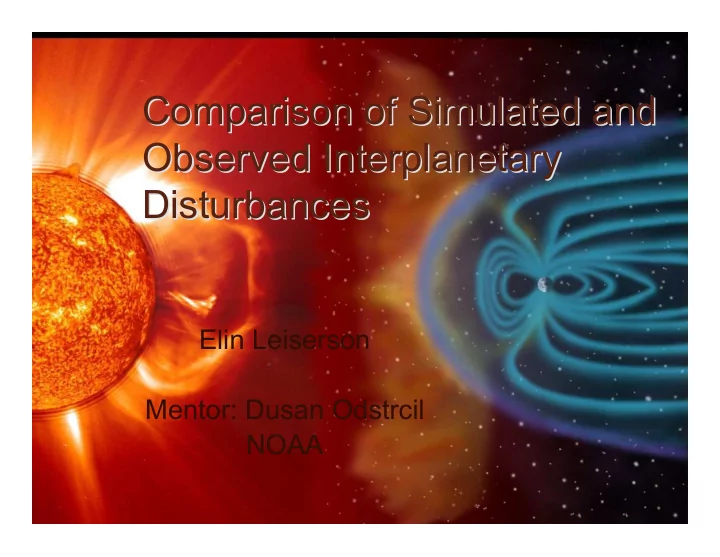

Comparison of Simulated and Comparison of Simulated and Observed Interplanetary Observed Interplanetary Disturbances Disturbances Elin Leiserson Mentor: Dusan Odstrcil NOAA
Outline Outline Why use ICME models in space weather forecasting (esp. when they are still in the research phase)? ENLIL-modeling code Project and purpose Results thus far Goals (what is to come)
Why use ICME models for space Why use ICME models for space weather forecasting? weather forecasting? Interplanetary Coronal Mass Ejections (ICME’s) can wreak havoc on our technological society For a 1000 km/s ICME, it only takes about 25 min for it to get to Earth from Lagrange Point 1 Currently, when an ICME first goes off, it takes 12-40 hours to numerically compute the arrival time (depending on computer speed and access) Thus it is important to have a procedure or formula based off models as well as data to aid in estimating and predicting ICME potentials and arrival times
ENLIL— — “ “Lord of the Air Lord of the Air” ” ENLIL 3D numerical magnetohydrodynamic code used to simulate ICME events. Solves equations for plasma mass, momentum, energy density, and magnetic field, using a Total- Variation-Diminishing Lax-Friedrichs (TVDLF) algorithm ◦ TVDLF algorithm is an explicit scheme for solving Euler and hyperbolic equations for fluid dynamics ◦ Useful for studying shocks
Larger Lead Time of Geoeffectivity Predictions DAY 4 DAY 1 DAY 2 DAY 3 ACTIVE REGION ACTIVE REGION ACTIVE REGION ACTIVE REGION EJECTA SHOCK SHOCK SHOCK EARTH EARTH EARTH EARTH Probabilities of the solar eruption (A%), interplanetary shock (B%), and ejecta (C%), and geo-effectivity (D%) before the actual eruption Pre-computed scenarios ready if actual eruption happens
Global Properties of Transient Disturbances High-resolution parameterized study needed to determine: Probability of interplanetary shock hitting geospace Probability of coronal ejecta hitting geospace And derive empirical formulae for various scenarios
Project Goals Project Goals Complete parametric study with various ejecta Compare with spacecraft observations of real events Determine the values of free parameters providing the best match for each specific event Verify whether the same values of the free parameters can be used for all events.
Parameters of Study Parameters of Study Free parameters of ejecta ◦ Initial Velocity Range (500-2000 km/s) ◦ Angular width Range (40-180 degrees) *input as “radius,” which is half the angular width ◦ Density Enhancement (2-8 x solar wind density) Free parameters of background ◦ Solar wind velocity
Simulated CME— velocity=1000 km/s, radius=40, density=6
Simulated CME— velocity=1000 km/s, radius=40, density=6
Simulated CME— velocity=1000 km/s, radius=40, density=6
Simulated CME— velocity=1000 km/s, radius=40, density=6
Simulated CME— velocity=1000 km/s, radius=40, density=6
Initial Velocity vs. time Initial Velocity vs. time
Initial Velocity vs. time Initial Velocity vs. time
Initial Velocity vs. time Initial Velocity vs. time
Initial Velocity vs. time Initial Velocity vs. time
Radius vs. time Radius vs. time
Radius vs. time Radius vs. time
Radius vs. time Radius vs. time
Radius vs. time Radius vs. time
Varying the solar wind velocity (Vamb Vamb) ) Varying the solar wind velocity ( Vamb=350 km/s; arrival time =350 km/s; arrival time ≈ ≈ 2.6 days 2.6 days Vamb • 700
Varying the solar wind velocity (Vamb Vamb) ) Varying the solar wind velocity ( Vamb=450 km/s; arrival time =450 km/s; arrival time ≈ ≈ 2.45 days 2.45 days Vamb • 700
Varying the solar wind velocity (Vamb Vamb) ) Varying the solar wind velocity ( Vamb=550 km/s; arrival time =550 km/s; arrival time ≈ ≈ 2.3 days 2.3 days Vamb • 700
Varying the solar wind velocity (Vamb Vamb) ) Varying the solar wind velocity ( Vamb=650 km/s; arrival time =650 km/s; arrival time ≈ ≈ 2.2 days 2.2 days Vamb • 700
Time vs. Density— —varying varying Time vs. Density resolutions resolutions
Time vs. Density— —varying varying Time vs. Density resolutions resolutions
Future goals Future goals Compare results with observed data Derive an empirical forecasting model in which given a known density, radius, and velocity, arrival time can be predicted
Recommend
More recommend